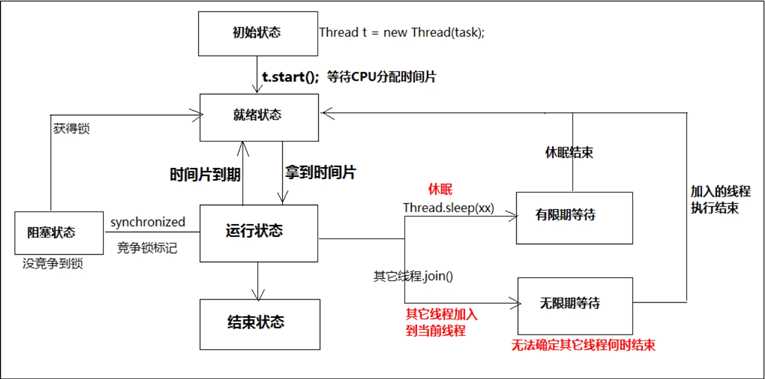标签:cat get 解锁 ati 路径 类型 img err 性能
一、进程/线程:
1.进程:是一个正在执行的程序;进程是资源管理的最小单位;
//每一个进程执行都有一个执行顺序;该顺序是一个执行路径,或者叫一个执行单元;
2.线程:是进程中一个独立的控制单元;线程不能管理资源;
//线程在控制着进程的执行;
PS:一个进程中至少有一个线程;
二、创建线程的两种方式:
1、继承Thread类:
(1)定义类继承Thread;
(2)复写Thread中的run方法;
(3)创建类继承Thread的类对象;
(4)调用线程的start()方法:1)启动线程;2)调用run方法;
PS:1)如果不使用start(),而使用run(),则为正常调用函数,不开启线程;
2)start()仅仅是通知线程开始,只有争取到时间片后才开始运行;
public class ThreadTest { public static void main(String args[]) { MyThread mt1 = new MyThread(); MyThread mt2 = new MyThread(); mt1.start(); mt2.start(); for (int i = 0; i < 100; i++) { System.out.println("主线程:"+i); } System.out.println("执行完成"); } } class MyThread extends Thread { @Override public void run() { for (int i = 0; i < 100; i++) { System.out.println(this.getName() + ":" + i); } } }
2、实现runnable接口:
(1)定义类实现(implements)Runnable接口;
(2)覆盖Runnable中的run方法;
(3)通过Thread类建立线程对象;
(4)将Runnable接口中的子类对象作为实际参数传递给Thread类的构造函数;
//传入对象是为了让Thread执行指定的run方法;
(5)调用Thread类的start方法开启线程并调用Runnable接口子类的run方法;
public class RunnableTest { public static void main(String args[]) { Runnable myThread = new MyThread(); Thread thread1 = new Thread(myThread); Thread thread2 = new Thread(myThread); thread1.start(); thread2.start(); System.out.println("执行结束"); } } class MyThread implements Runnable { @Override public void run() { for (int i = 0; i < 100; i++) { System.out.println(Thread.currentThread().getName() + ":" + i); } } }
3、实现和继承两种方式的区别:
(1)java为单继承,继承Thread后,则无法再继承其他类;
(2)继承的线程代码存放在Thread的子类中;实现的线程代码存放在接口的子类中;
4、两种方式的匿名实现:
public class Test { public static void main(String[] args) { //匿名继承Thread类 demo1(); //匿名实现Runnable接口 demo2(); } private static void demo1() { // new一个类(){},继承Thread这个类 new Thread() { @Override public void run() { for (int i = 0; i < 100; i++) { System.out.println(this.getName() + ":" + i); } } }.start(); } private static void demo2() { //将Runnable的子类对象当作参数传递给Thread的构造方法;new Runnable(){}:实现Runnable接口; new Thread(new Runnable() { @Override public void run() { for (int i = 0; i < 100; i++) { System.out.println(Thread.currentThread().getName() + ":" + i); } } }).start(); } }
三、线程方法:
(1).getName();获得线程的名称;(用于继承时获取线程名)//this.getName()
(2)Thread.currentThread();获取创建当前线程的对象;==this;(用于实现时获取线程名)//Thread.currentThread().getName();
(3)设置线程的名称:1)构造函数传入name;2)setName;
(4)obj.join();让指定线程加入执行,当前线程进入就绪状态不再执行,但是其他进程还是会抢时间片;加入的指定线程执行完后,当前线程开始执行;
public class RunnableTest { public static void main(String args[]) throws InterruptedException { Runnable myThread = new MyThread(); Thread thread1 = new Thread(myThread); Thread thread2 = new Thread(myThread); thread1.start(); thread2.start(); for (int i = 0; i < 100; i++) { thread1.join(); System.out.println("主线程:"+i); } System.out.println("执行结束"); } } class MyThread implements Runnable { @Override public void run() { for (int i = 0; i < 100; i++) { System.out.println(Thread.currentThread().getName() + ":" + i); } } }
(5)obj.sleep(毫秒[,纳秒]);休眠;休眠状态结束后进入就绪状态;
(6)obj.yield();让出时间片;线程进入到就绪状态;
//yield进入到就绪状态,还会争抢时间片,所有yield之后可能还是它第一个运行;
四、多线程状态:

五、多线程安全问题
(1)问题原因:多条语句在操作同一个线程共享数据时,一个线程对多条语句只执行了一部分,还没有执行完,另一个线程参与进来执行,导致共享数据错误;
(2)解决办法:对多条操作共享数据的语句,只能让一个线程都执行完。再让其它线程进入;
public class Test { public static void main(String args[]) { Runnable myThread = new MyThread(); Thread thread1 = new Thread(myThread); Thread thread2 = new Thread(myThread); thread1.start(); thread2.start(); } } class MyThread implements Runnable { private int num = 100; @Override public void run() { while (true) { if (num > 0) { try { Thread.sleep(10); } catch (Exception e) { } num--; System.out.println(Thread.currentThread().getName() + ":" + num); } } } }
六、同步代码块synchronized;
(1)同步代码块:synchronized(对象){需要被同步的代码};
(2)同步方法:访问修饰符 synchronized 返回值类型 方法名(){};
//区别:同步代码块可以指定锁;同步方法的锁只能是this;
//同步前提:1)两个或以上多线程;2)同一个对象(锁);
(3)缺点:
1)死锁:请求互斥 请求保持 不可剥夺 形成环路;
2)性能低;
3)无法灵活的加锁,解锁;
1)同步方法:
public class Test { public static void main(String args[]) { Runnable myThread = new MyThread(); Thread thread1 = new Thread(myThread); Thread thread2 = new Thread(myThread); thread1.start(); thread2.start(); } } class MyThread implements Runnable { private int num = 100; @Override public synchronized void run() { while (true) { if (num > 0) { try { Thread.sleep(10); } catch (Exception e) { } num--; System.out.println(Thread.currentThread().getName() + ":" + num); } } } }
2)同步代码块:
public class Test { public static void main(String args[]) { Runnable myThread = new MyThread(); Thread thread1 = new Thread(myThread); Thread thread2 = new Thread(myThread); thread1.start(); thread2.start(); } } class MyThread implements Runnable { private int num = 100; @Override public void run() { while (true) { synchronized (MyThread.class) { if (num > 0) { try { Thread.sleep(10); } catch (Exception e) { } num--; System.out.println(Thread.currentThread().getName() + ":" + num); } } } } }
标签:cat get 解锁 ati 路径 类型 img err 性能
原文地址:https://www.cnblogs.com/Tractors/p/11302389.html